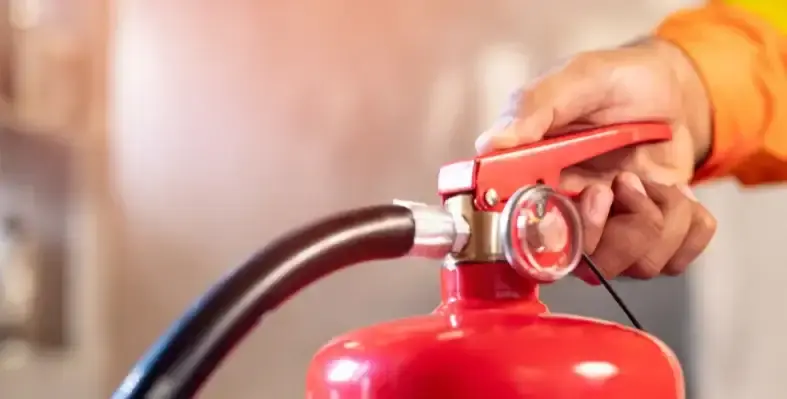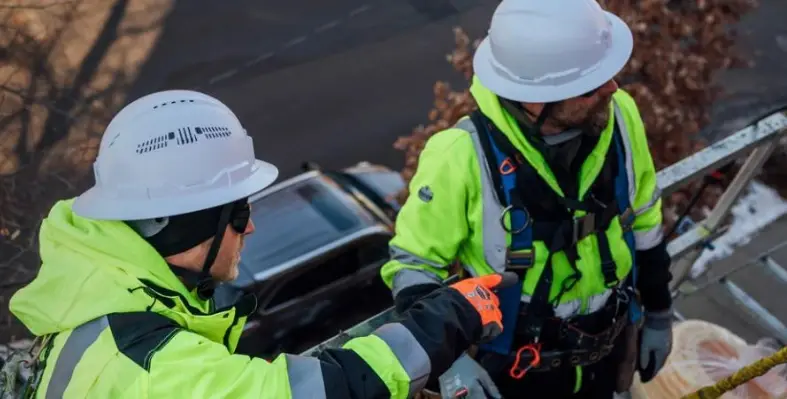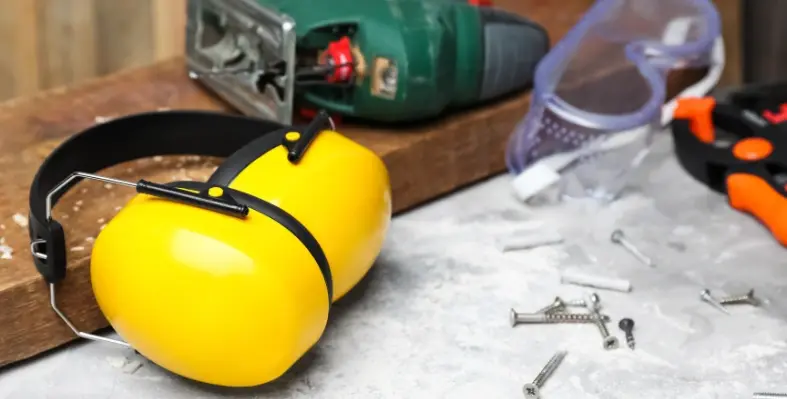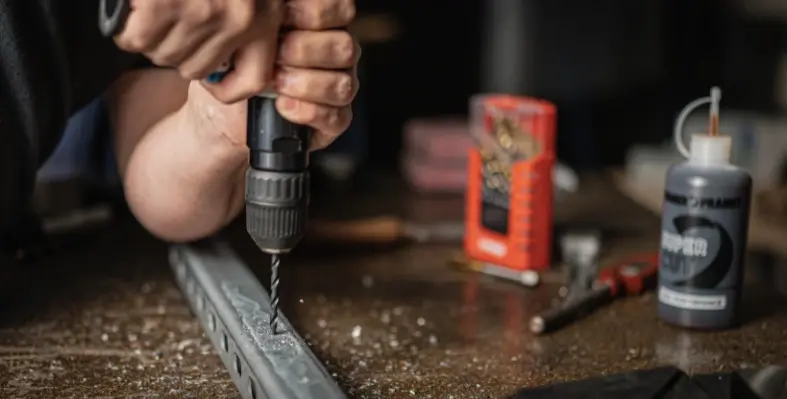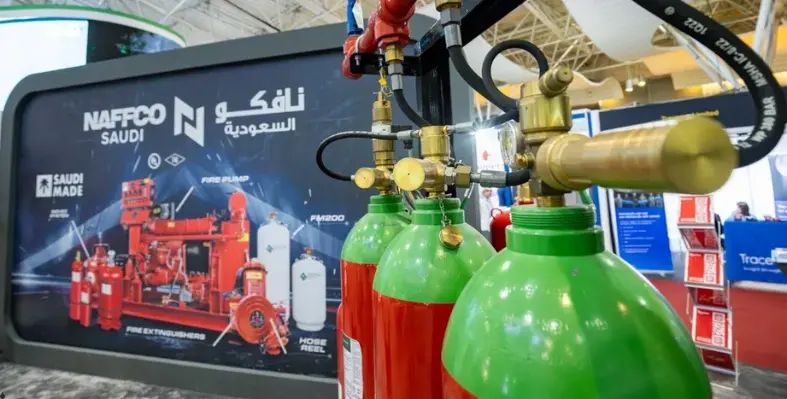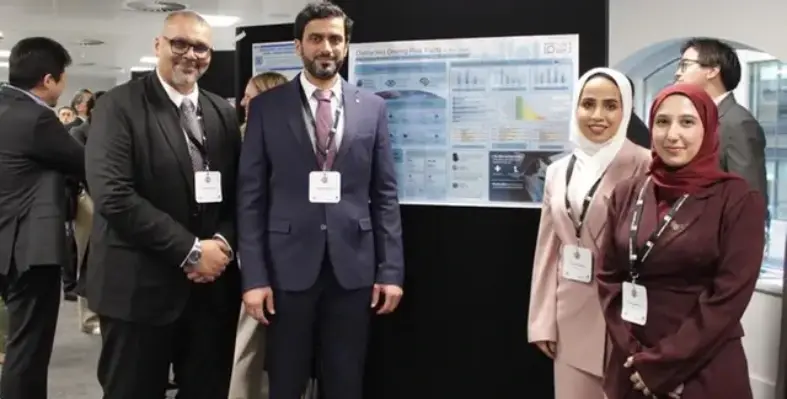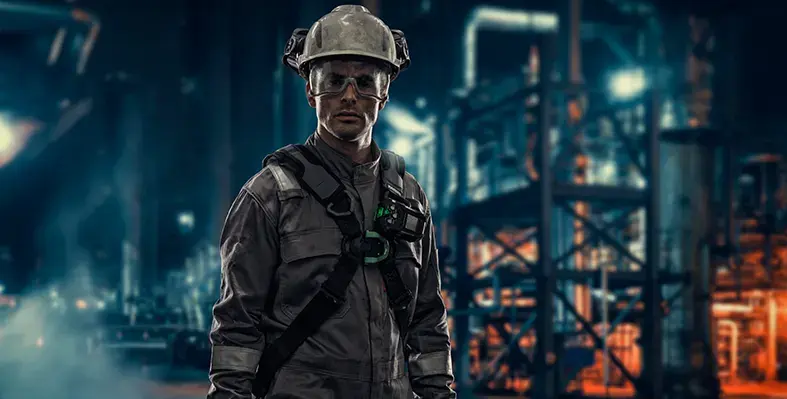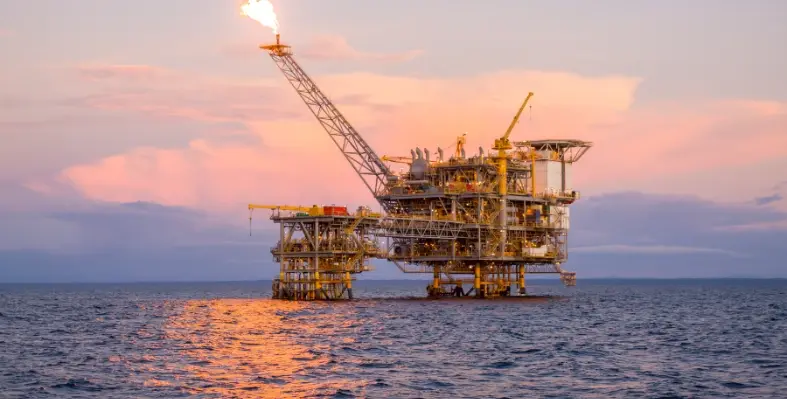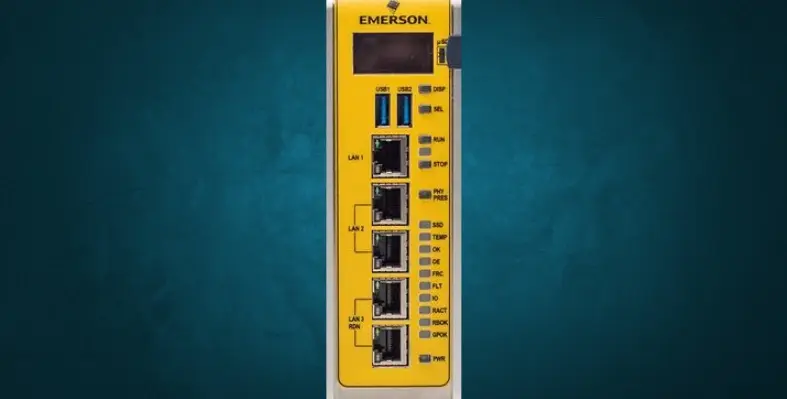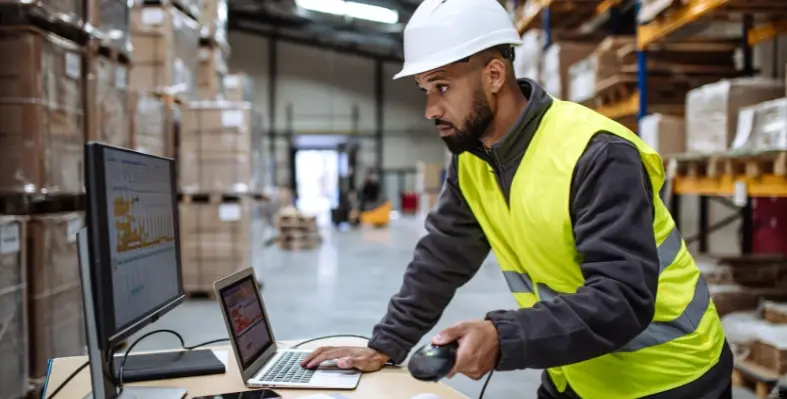Industrial Insights
Industrial Insights
- Details
- Sania Aziz
- Industrial Insights
- Date: 24 September, 2025
- Year: 2025
Two distinguished leaders in the health, safety, and environmental field have been recognised with the NEBOSH Honorary Diploma, celebrating their lifelong dedication to workplace wellbeing.
Errol Galloway and Manal Azzi received the honour at the NEBOSH Graduation Ceremony in the UK this September, highlighting their influential contributions to global HSE standards and their role in protecting lives across industries.
Galloway, who began his career in Sheffield’s steel industry, went on to serve in the Health and Safety Executive, HM Railway Inspectorate, and the Office of Rail and Road, where he was Principal Inspector. His leadership and technical expertise have set new benchmarks for compliance and safety in the rail sector, improving workplace culture and inspiring others to prioritise safety.
Azzi, Team Lead on Occupational Safety and Health at the International Labour Organization, manages a wide portfolio covering chemical safety, environmental health, stress management, and workplace violence prevention. She also leads the World Day for Safety and Health at Work campaign and has authored influential reports addressing climate change, heat stress, AI, and digitalisation in occupational health and safety.
“I am honoured and humbled by this award. Being able to contribute to the development and delivery of health and safety standards in a variety of industries, both large and small, has given me great satisfaction,” said Errol.
“To be recognised with the NEBOSH Honorary Diploma is a matter of great esteem for me. Congratulations to this year’s graduates and fellow Honorary Diplomate. I am both confident and proud to say that our collective work as H&S professionals, underpinned by the knowledge developed through the world-class training provided by NEBOSH, continues to make a difference to the working lives of others.”
Manal said, “It is a true honour to receive this recognition from NEBOSH and to be part of such a meaningful occasion. Having dedicated over two decades to promoting safety and health at work, I know the commitment it takes to pursue this path. Standing alongside this year's Diplomates - professionals who have invested so much to protect the wellbeing of others - is deeply inspiring. I hope this passion and determination can be passed on to the next generation of leaders who will carry forward the global mission of safer, healthier workplaces for all”.
- Details
- Sania Aziz
- Industrial Insights
- Date: 23 September, 2025
- Year: 2025
Fire chiefs from Australia, Canada, Mexico, the Netherlands, Slovenia, the United Kingdom, and the United States gathered at NFPA headquarters in Quincy, Massachusetts, for the annual Urban Fire Forum (UFF).
Organised by the National Fire Protection Association (NFPA), the 2025 event strengthened international collaboration while addressing the most pressing challenges facing fire and emergency services.
The agenda focused on a wide range of issues, including the growing threat of wildfire-driven urban conflagrations, the risks associated with lithium-ion batteries, data-driven approaches to emergency planning, national mutual aid systems, and the evolving role of fire service leadership in shaping both public safety and policy.
At the close of discussions, the chiefs formally endorsed five position papers that will serve as official UFF–Metropolitan Fire Chiefs (Metro Chiefs) position statements. These statements offer strategic guidance on firefighter safety, leadership, and coordination across national and international levels. The position papers include Combating the Assault on Codes and Standards – Fire Service Leadership Toolkit, National Fire Apparatus Specification, Support for Advancing National Fire and Emergency Services Capabilities Through Strategic Leadership and Unified Advocacy, Statement in Support of Reauthorization of FirstNet, and Confronting the Risk of Wildfire-Initiated Urban Conflagrations.
In addition, the Forum endorsed a sixth deliverable: an informational bulletin titled Enhanced Tactical Considerations for Fighting Lithium-Ion Battery Electric Vehicle (EV) Fires. This bulletin will be released alongside a Fire Protection Research Foundation research report, offering critical guidance for fire departments faced with the increasing hazards posed by EV battery incidents.
Together, these outcomes highlight the Forum’s commitment to strengthening global fire service readiness, improving firefighter safety, and advancing coordinated strategies to meet the challenges of a rapidly evolving risk landscape.
"Today’s fire and emergency services face challenges that reach far beyond traditional response," said Otto Drozd III, Executive Secretary of the Metro Chiefs and UFF facilitator. "The position papers endorsed this year focus on strengthening leadership, advancing national coordination, standardizing apparatus, and addressing emerging threats such as wildfire-driven urban conflagrations and lithium-ion battery hazards. These deliverables provide critical guidance for departments navigating an increasingly complex environment and highlight the need for collaboration across all levels of government and the private sector."
- Details
- Sania Aziz
- Industrial Insights
- Date: 22 September, 2025
- Year: 2025
Ergodyne has launched its new Type 2 safety helmets, designed to bridge the gap between traditional hard hats and modern protective gear by combining the familiar full brim style with the advanced protection of Type 2 certification.
The release comes as momentum grows for wider adoption of safety helmets following OSHA’s Safety and Health Information Bulletin (SHIB 03-06-2024), which highlighted their superior protection and confirmed OSHA’s own transition to using them.
Unlike Type 1 hard hats, tested only for top impact, Type 2 helmets are tested against side, front and rear impacts, offering protection better aligned with workplace realities such as slips, trips, falls and angled strikes. According to the Center for Construction Research and Training (CPWR), just 15% of impacts actually occur on the crown, underlining the limitations of older designs.
Despite these advantages, many crews have resisted switching due to their attachment to the look and feel of traditional hard hats. Ergodyne’s new model seeks to overcome this resistance by maintaining the recognizable full brim silhouette, while offering greater safety and comfort.
The helmet features a ventilated foam design to reduce heat buildup, a six-point suspension with a 36-point ratchet for a secure fit, and integrated slots for accessories including fans, lights, visors and hearing protection.
With its combination of familiarity, comfort and enhanced protection, Ergodyne’s latest helmet aims to encourage broader acceptance of Type 2 models across industries where head injuries remain a critical safety concern.
“Type 2 really expands coverage—not just from falling objects, but from slips, trips, and falls where you’re more likely to strike the side of your head,” said Ergodyne Product Manager, Justin Schuetz.
“We know workers have a personal relationship with their hard hats, and the look matters,” Schuetz added. “That’s why we introduced a full brim style. It’s familiar to construction crews, it looks good, and it adds real function against sun, rain, and debris. Pair that with a precision fit system and ventilation that keeps you cooler when compared to other options, and you’ve got a helmet workers want to wear—not just one they’re told to.”
- Details
- Sania Aziz
- Industrial Insights
- Date: 19 September, 2025
- Year: 2025
The hearing protection devices (HPDs) market is experiencing significant momentum worldwide, fuelled by growing awareness of occupational safety, rising noise pollution levels, and an increasing emphasis on worker health and productivity.
These devices, which include earplugs, earmuffs, and advanced electronic protectors, are designed to reduce noise exposure and prevent hearing loss.
They are widely used across industries such as construction, mining, manufacturing, defence, and transportation, where workers are routinely exposed to hazardous sound levels.
According to Persistence Market Research, the global HPDs market is projected to be valued at US$2.4bn in 2025 and is expected to reach US$4.2bn by 2032, registering a compound annual growth rate (CAGR) of 8.2%. This growth trajectory reflects the tightening of workplace safety regulations, the rapid pace of industrialisation in emerging economies, and rising demand for technologically integrated solutions that combine effective protection with enhanced comfort and usability.
With noise-induced hearing loss (NIHL) ranking among the most common occupational health conditions worldwide, industries are under increasing pressure to invest in protective measures that mitigate long-term health risks and related costs. Employers are recognising that protecting hearing is not just a compliance issue but also an essential part of maintaining workforce productivity and well-being.
Technological innovation is playing a pivotal role in reshaping the industry. The development of smart and electronic hearing protectors with features such as Bluetooth connectivity, active noise cancellation, and real-time monitoring is transforming how workers experience protection. These devices not only improve safety outcomes but also enable situational awareness, allowing users to hear essential alarms or communicate effectively while remaining protected.
Manufacturers are investing in ergonomic designs, lightweight materials, and customised fits to address one of the sector’s ongoing challenges: comfort and compliance. Long-term usage of hearing protection can sometimes be uncomfortable, leading to inconsistent adoption, and resolving this issue remains central to ensuring effectiveness.
Cost also presents a barrier, particularly for small and medium-sized enterprises in developing economies, where advanced devices may be prohibitively expensive. Additionally, in low-income regions, a lack of awareness about hearing hazards and weaker enforcement of regulations continue to slow widespread adoption.
Dual-protection systems that combine passive and electronic technologies are also becoming popular in high-risk industrial and defence applications. Looking ahead, the hearing protection devices market is set to expand as stricter regulatory frameworks, awareness campaigns, and technological integration drive adoption. For employers, effective deployment of HPDs will not only support compliance but also safeguard one of the most valuable and irreplaceable human senses: the ability to hear.
- Details
- Sania Aziz
- Industrial Insights
- Date: 18 September, 2025
- Year: 2025
A new campaign titled Bad Vibrations has been launched by the British Safety Industry Federation (BSIF) to address confusion surrounding Hand-Arm Vibration Syndrome (HAVS), a serious workplace health risk.
The campaign was developed by BSIF’s Measurement and Instrumentation Special Interest Group, which includes test houses, certification bodies, manufacturers and distributors.
While a wide range of technical material already exists on HAVS, much of it is difficult for those directly exposed to vibrating tools and equipment to navigate.
The Bad Vibrations guide has been designed to simplify this information, presenting the essential facts in a straightforward and accessible way.
It explains what HAVS is, the types of tools most commonly associated with it, methods for controlling exposure in the workplace, how vibration is measured, and the relevant standards that should be followed.
The guide also provides links to further resources for those who want more detail.
HAVS remains a widespread and preventable health issue, with more than two million people at risk each year from the prolonged use of vibrating tools.
The condition can cause painful, permanent damage, but early awareness and the right protective measures can significantly reduce the risk.
By publishing Bad Vibrations, BSIF aims to make critical knowledge more approachable and ensure that workers and employers alike have the information they need to safeguard against HAVS.
The guide is available to download from the BSIF website.
- Details
- Sania Aziz
- Industrial Insights
- Date: 17 September, 2025
- Year: 2025
Fire safety in airports, among the most complex and high-stakes environments in the built world, will be a focal point at the Fire Protection and Technology Summit during Intersec Saudi Arabia. The event, scheduled from 29 September to 1 October at the Riyadh International Convention and Exhibition Center (RICEC), will gather global experts to address the latest innovations and challenges in fire protection.
The summit will open with a session led by representatives from King Fahd International Airport (KFIA), one of Saudi Arabia’s busiest hubs, which handled more than 12mn passengers in 2024. Senior Manager for Fire Prevention, Eng. Hussein Mohammed Rajab, alongside his colleague Mohamed, will present strategies designed to protect both airside and landside operations. Their discussion will emphasise how systematic fire prevention measures not only mitigate risk but also safeguard operational continuity and reduce the heavy costs associated with emergencies.
From a landside perspective, KFIA has invested in passive fire protection, advanced suppression systems for retail areas, and comprehensive evacuation planning. Airside, the focus is on the deployment of foam deluge systems, high-reliability detection technologies, and rapid-response firefighting units, ensuring readiness for incidents in highly sensitive zones.
The session will also address the importance of integrating international fire codes with local regulatory requirements. By blending global best practices with the realities of Saudi operations, airports can achieve what speakers describe as “hybrid compliance,” offering both safety assurance and adherence to regulatory frameworks while accounting for the unique risks posed by individual facilities.
Expanding the discussion beyond aviation, the summit will showcase expertise from leading fire safety professionals worldwide. Terrance Tsang, Chief Fire Officer of the Hong Kong Fire Services Department, will deliver a keynote on raising fire safety standards in super high-rise buildings under construction—an area of growing relevance in the Kingdom’s rapidly urbanising landscape. Meanwhile, Abdullah Abdulrahman Alrommani, Assistant Director of Quality and Safety Management at SASCO, will share insights on strengthening fire protection across fuel stations, a critical component of national infrastructure.
The second day of the summit will be led by the National Fire Protection Association (NFPA), a key driver of global fire and life safety standards. The NFPA programme will demonstrate how international codes can be adapted to support Saudi Arabia’s Vision 2030, particularly in ensuring resilient infrastructure and safer communities.
Intersec Saudi Arabia will also feature the Future Security Summit, powered by ASIS International Dhahran Chapter. This segment will bring discussions on emerging global threats, crisis response strategies, critical infrastructure protection, responsible AI integration in security, and the importance of diversity in building robust security frameworks.
By convening leaders from aviation, construction, and critical infrastructure, Intersec Saudi Arabia underscores its role as a platform for knowledge exchange and innovation. With airports like KFIA setting the standard for fire prevention and emergency readiness, the summit promises to highlight how proactive safety measures can help meet the Kingdom’s growth ambitions while protecting lives and assets.
- Details
- Sania Aziz
- Industrial Insights
- Date: 16 September, 2025
- Year: 2025
The Integrated Transport Centre (ITC), part of Abu Dhabi’s Department of Municipalities and Transport, has taken part in the 20th International Conference on Road Safety on Five Continents (RS5C), held recently in Leeds, United Kingdom.
Organised by the Swedish National Road and Transport Research Institute (VTI), RS5C gathered international experts, policymakers and researchers to discuss the latest developments in road safety and mobility. The event served as a platform to share knowledge, present cutting-edge research, and explore innovative solutions for safer and more sustainable transport systems.
The ITC delegation presented a research paper titled “Risk Analysis of Distracted Driving Behaviour: A Case Study of the Emirate of Abu Dhabi” during the scientific poster session on the opening day. The paper sparked engaging discussions with global specialists, highlighting the risks of driver distraction and offering evidence-based insights into strategies for reducing accidents in Abu Dhabi. The exchange of ideas provided an opportunity for ITC to learn from international best practices while showcasing the emirate’s progress in advancing road safety research.
Throughout the conference, ITC representatives explored new methodologies for assessing safety strategies, modelling accident risks, and integrating multiple data sources into road safety planning. Sessions also examined how machine learning can help understand the interaction between drivers, vehicles and the surrounding environment. Advanced analytics for classifying urban roads and monitoring key risk indicators were also a focus, demonstrating the potential of data-driven approaches to make mobility systems safer.
The delegation’s participation aligns with Abu Dhabi’s long-term goal of Vision Zero, which aims to eliminate road fatalities through continuous innovation and investment in sustainable mobility. By presenting original research and engaging in global knowledge exchange, ITC underscored the emirate’s commitment to adopting modern technologies and practices that reduce risks for road users.
The event reaffirmed Abu Dhabi’s position as a regional leader in road safety and mobility innovation. By engaging with leading institutions and experts on a global stage, ITC is contributing to the development of more resilient and forward-looking transport systems, supporting the emirate’s ambition to be recognised as a global benchmark in safe and sustainable mobility.
Eng. Abdulla Hamad Al Eryani, Acting Executive Director of the Planning and Strategic Affairs Sector at the Integrated Transport Centre, said, “ITC’s involvement in this international forum reflects Abu Dhabi’s commitment to employing the latest global practices in road safety. By harnessing technology, leveraging data and analysis, and strengthening collaboration with international partners, we aim to build a safer and more sustainable mobility system that supports the Emirate’s long-term aspirations.”
- Details
- Sania Aziz
- Industrial Insights
- Date: 15 September, 2025
- Year: 2025
ACCIONA has unveiled Atlas, an innovative digital platform designed to make construction projects significantly safer while also enhancing efficiency and sustainability. The system is part of the company’s commitment to driving smarter and more resilient infrastructure in line with regional development and sustainability goals.
At the core of Atlas is a suite of real-time monitoring and control tools that help reduce risks on construction sites. Key safety features include continuous air quality monitoring to detect harmful emissions, emergency alert systems that allow for immediate response to incidents, video surveillance to ensure safer working environments, and worker location tracking to improve evacuation procedures and prevent accidents in restricted areas.
Beyond direct safety measures, Atlas supports safer project delivery by integrating tunnel boring machine data, geotechnical monitoring, concrete traceability, and earthwork production tracking. These functions allow for earlier detection of potential hazards and ensure that quality standards are consistently met. By consolidating these capabilities into one platform, project managers gain greater visibility and control, reducing the likelihood of accidents while ensuring compliance with strict safety regulations.
The platform is modular and scalable, meaning it can be tailored to the specific needs of projects ranging from tunnels and railways to ports, highways, and buildings. In addition to safety, Atlas incorporates environmental monitoring tools that align with sustainability agendas such as Saudi Arabia’s Vision 2030 and the UAE Net Zero 2050 strategy. These features help track environmental impact, manage inventories and maintenance digitally, and ensure safer and more sustainable operations.
Atlas has already proven its value in international projects. In the United States, it is deployed on the Fargo-Moorhead Flood Diversion project, where it supports decarbonisation efforts alongside operational safety. In Brazil’s São Paulo Metro Line 6, Atlas enhances tunnel boring machine and instrumentation monitoring, while in Chile and Poland it has been applied to optimise asset tracking and strengthen safety systems in complex projects.
By introducing Atlas to the Middle East, ACCIONA aims to accelerate the region’s digital transformation in construction while raising the bar for workplace safety. The platform offers project owners and contractors the tools to create safer working environments, improve incident response, and deliver infrastructure that is not only efficient and sustainable but also built with worker safety at its core.
- Details
- Sania Aziz
- Industrial Insights
- Date: 4 September, 2025
- Year: 2025
In high-risk industries, safety is the foundation of productivity, quality, and trust. Yet too often it is reduced to a compliance exercise.
For safety managers and site leaders, the opportunity is to shift this mindset.
By treating safety as a core value, not just a legal duty, leaders can build trust, boost morale, and empower teams to take ownership of their protection.
Beyond compliance
Regulations are the baseline, but when safety becomes a tick-box task, engagement suffers.
PPE and protocols risk being seen as burdens rather than lifesaving tools.
True safety leadership reframes protection as a personal investment in people’s wellbeing.
PPE as a leadership choice
Every decision signals priorities, and few are more visible than PPE.
Choosing protection that is comfortable, high-performing, and easy to use shows commitment to people, not paperwork.
Workers are more likely to embrace equipment that’s designed with them in mind.
Building trust together
Involving employees in PPE trials and feedback builds trust and ensures equipment works in real conditions.
When leaders model safe behaviour, engage teams, and close the feedback loop, safety becomes embedded in daily culture.
The result can be higher morale, fewer incidents, and a reputation for valuing worker wellbeing.
Lead with protection, not just policy, and safety will follow. At MSA, we design PPE that fits, functions, and protects without compromise.
Ready to elevate your safety standards? Try our Head and Fall Protection ranges for free.
This article was written by MSA Safety.
- Details
- Sania Aziz
- Industrial Insights
- Date: 12 September, 2025
- Year: 2025
AkzoNobel’s protective coatings brand, International, has unveiled its epoxy passive fire protection (PFP) system, Chartek ONE, to a global audience at GasTech 2025, following its successful Middle East debut last year.
Chartek ONE is designed as a single-coat, mesh-free solution that simplifies application while delivering comprehensive protection for energy sector assets. By streamlining installation, the product boosts efficiency, improves workplace safety, and provides robust defence against a wide range of fire scenarios. It offers up to three hours of resistance to jet and pool fires, withstands cryogenic and hydrocarbon fire exposure, and delivers strong corrosion protection across varied operating temperatures.
Sustainability has been embedded in its design. Chartek ONE is formulated with 100% solids, free from boron and chlorinated plasticisers, lowering both occupational risks and environmental impact. Its mesh-free technology eliminates the need for reinforcement in jet and pool fire scenarios, reducing installation time, labour, and material costs while cutting down overall system weight, an important factor in weight-sensitive industries such as offshore oil and gas.
The system has demonstrated significant efficiency gains, with installation time in workshops reduced by up to 59%, offering tangible cost savings throughout a project’s lifecycle. Certified to meet leading international standards, including NORSOK M-501 Revision 7, ISO 21843, ISO 22899, and UL1709 Edition 5, Chartek ONE has also undergone rigorous real-world testing. Trials included exposure to jet fires, weathered beam performance, and termination detailing, areas where PFP systems often fail. By exceeding minimum testing benchmarks, the coating offers proven reliability beyond the laboratory.
AkzoNobel’s commitment to sustainability is reinforced by its top-tier rankings in global ESG indices such as Sustainalytics and EcoVadis, placing it among the leading one per cent of companies worldwide. This focus on reducing environmental impact throughout development adds to customer confidence in Chartek ONE’s durability, safety, and eco-performance.
Now available to customers across Europe, Chartek ONE joins AkzoNobel’s established portfolio of coatings trusted in some of the world’s harshest operating environments.
- Details
- Sania Aziz
- Industrial Insights
- Date: 11 September, 2025
- Year: 2025
Emerson has announced the new PACSystems RX3i CPS400 Safety Controller, designed to enable Safety Integrity Level 2 (SIL2) strategies for infrastructure, fire and gas, burner management systems, and other emergency shutdown systems.
The PACSystems Safety Controller is a compact, high-performance solution with robust security measures and a scalable architecture with 2,000 available I/O points, ideal for complex projects with evolving requirements.
As project automation becomes more sophisticated and data-driven, OEMs and systems integrators need a range of more powerful hardware and software products to ensure compliance with standards and regulations for protecting workers, whether onboard a single piece of equipment or distributed across a larger process.
With a large 64-megabyte memory capacity and scalable digital architecture, the PACSystems Safety Controller supports a wide range of mission-critical applications.
Using built-in industrial communications protocols, including OPC UA, Ethernet Global Data (EGD), and Modbus TCP, the RX3i CPS400 controller is ready for peer-to-peer connections and integration with higher-level hosts, providing complete operational visibility.
As a secure-by-design solution incorporating Secure Boot and Trusted Platform Module (TPM) standards, the controller delivers strong data integrity and protection against potential threats.
Safety-certified function blocks and pre-configured templates simplify system certification in accordance with the IEC 61511 standard.
Available in simplex or redundant configurations, the RX3i CPS400 controller can perform all safety data messaging with duplex communications using the black channel principle over EGD, enabling standardized and reliable connectivity with Emerson’s PACSystems VersaMax SafetyNet I/O system.
The platform is IEC 61508 safety-certified, providing a capable SIL2 solution to help designers build appropriate protection schemes.
Developers can configure the controller using familiar software tools employed for programmable logic controllers (PLC), operator interfaces, and other automation elements through Emerson’s PAC Machine Edition development environment.
This unified tool chain with a user-friendly interface streamlines development efforts, allowing users to create integrated automation, visualisation, and safety solutions for rapid startups and maximum operating efficiency.
“Adding the PACSystems RX3i CPS400 Safety Controller to our extensive portfolio of safety products, we continue to deliver tools users need to create compliant safety systems that are easily developed and integrated into sophisticated automation solutions,” said Daniel Smith, senior product manager with Emerson’s discrete automation business.
- Details
- Sania Aziz
- Industrial Insights
- Date: 10 September, 2025
- Year: 2025
3E, a global leader in regulatory compliance and workplace safety solutions, has announced that its AI assistant within the 3E Insight chemical regulatory compliance platform has been recognised as New Product of the Year in the EHS Software category.
The award highlights 3E’s ongoing focus on innovation and excellence.
The AI assistant simplifies complex regulatory landscapes and supports proactive compliance strategies.
Embedded in the 3E Insight platform, it leverages proprietary data and advanced generative AI to provide precise, real-time answers to regulatory queries, interpret technical language, and connect users to critical chemical data.
Serving industries including chemicals, manufacturing, consumer products, pharmaceuticals, and retail, the assistant is a valuable tool for EHS and regulatory compliance professionals, product stewards, R&D scientists, and supply chain managers.
It helps users save time, reduce risk, and make informed decisions throughout the product lifecycle, reinforcing 3E’s position as a market-leading AI solution for product compliance.
"At 3E, our mission is to be the most trusted provider of compliance and sustainability intelligence for the global economy," said JP O’Sullivan, COO of 3E. "Our innovation is now fulfilling that mission via a new class of expert-led, trustworthy AI-powered solutions purpose-built to advance product compliance and workplace safety workflows. We will continue to innovate market-leading, expert-led AI solutions for product compliance."


